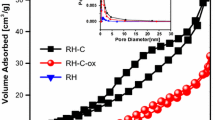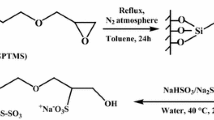Abstract
This work presents different methods of adsorbents characterisation. Their use towards improved removal of malodorous compounds is considered. These methods are applied to different modified silica gels. At first, the synthesis conditions were optimised using aminopropylsilanes. Afterwards the stability of the samples against ethanol and water was examined. The modified silica gels are suggested to be selective adsorbents in the field of odour control.
Access this chapter
Tax calculation will be finalised at checkout
Purchases are for personal use only
Preview
Unable to display preview. Download preview PDF.
Similar content being viewed by others
References
VDI-Guideline, VDI 3477 (2002) Biological waste gas purification — Biofilters.
VDI-Guideline, VDI 3477 (1996) Biological waste gas purification — Bioscruppers and trickle bed reactors.
VDI-Guideline, VDI 2442 (1987) Waste gas cleaning by thermal combustion.
VDI-Guideline, VDI 3476 (1990) Catalytic; exhaust gas purification.
VDI-Guideline, VDI 3674 (1998) Waste gas cleaning by adsorption — Process and waste gas cleaning.
Leffingwell, J.C. (2001) Olfaction, Leffingwell Reports 1, 1–24
Pauling, L. (1946) Molecular architecture and Biological Reactions, Chem. Eng. News 24, 1375–1377
Amoore, J.E. (1970) Molecular Basis of Odor, C.C. Thomas, Pub., Springfield
Dyson, G.M. (1938) The Scientific Basis of Odor, Chem. Ind. 57, 647–651
Wright RH (1982) The Sense of Smell, CRC Press, Boca Raton, USA
Turin, L. (1996) A spectroscopic mechanism for primary olfactory reception, Chem. Senses 21,773–791
Jones, K. (1987) Optimisation Procedure for the Silanisation of Silicas for Reversed-Phase High-Performance Liquid Chromatography-I. Elimination of Non-Significant Variables, J. Chrom. 392, 1–10.
Jones, K. (1987) Optimization procedure for the silanistion of silicas for reversed-phase high-performance liquid chromatography — II. detailed examination of significant, J. Chromatogr. 392, 11–16
Scholten, A.B., de Haan, J.W., Ciaessens, H.A., van de Ven, L.J.M., Cramers C.A. (1996) Fundamental Study of Residual Silanol Populations on Alkylsilane-Derivatized Silica Surfaces, Langmuir 12, 4741–4747
Czajkowska, T., Tittelbach, Y., Bereznitski, Y., Jaroniec, M. (1998) Adsorption, thermogravimetric, and Chromatographic studies of bare silicas and silica-based octyl bonded phases, J. Liq. Chrom. & Rel. Technol. 21, 1957–1977
Kinkel, J.N., Unger, K.K. (1984) Role of Solvent and Base in the Silanization Reaction of Silicas for Reversed-Phase High-Performance Liquid Chromatography, J. Chrom. 316, 193–200
Berendsen, G. E., Pikaart, K. A., de Galan, L. (1980) Preparation of various bonded phases for HPLC using monochlorosilanes, J. Liq. Chromatogr. 3, 1437–1464
Cheng, W., McCown, M. (1985) Effect of Alkyl chain length on surface silanization of silica, J. Chrom., 318, 173–185.
Waddell, T. G., Leyden, D. E., DeBello, M. T. (1981) The Nature of Organosilane to Silica-Surface Bonding, J. Am. Chem. Soc. 103, 5303–5307
P. Van Der Voort, E. F. Vansant (1996) Silylation of the Silicia Surface — A Review, Journal of Liquid Cromatography and Related Technology, 19, 2723–2752
Burns, G.Th., Deng, Q., Hahn, J.R., Reggio, G.L., Su, K. (2000): Method for removing metal contaminants from solution using mercapto-functional silica xerogels. US-Patent 6013187
Blitz, J. P., Shreedhara Murthy, R. S., Leyden, D. E. (1988) The role of amine structure on catalytic activity for silylation reactions with Cab-O-Sil, J. Colloid Interface Sci. 126, 387–392
Chiang, C.H., Ishida, H., Koenig, J.L. (1980) The Structure of gamma-Aminopropyltriethoxysilane on Glass Surfaces, J. Coll. Interf. Sci. 74, 396–404
Chiang, C.H., Liu, N., Koenig, J.L. (1982) Magic-Angle Cross-Polarization Carbon 13 NMR Study of Aminosilane Coupling Agents on Silica Surfaces. J. Coll. Interf. Sci. 86, 26–33
Goodwin, J. W., Harbron, R. S., Reynolds, P. A. (1990) Functionalization of collodial silica and silica surfaces via silylation reactions, Colloid Polym. Sci. 268, 766–777
Kallury, K. M. R., Cheung, M., Ghaemmaghami, V., Krull, U. J., Thompson, M. (1992) Silanization of oxidized silicon and aluminium surfaces with functionalized silanes with characterization by wettability, ellipsometry, XPS and quartz crystal microbalance studies, Colloids Surfaces 63, 1–9
Iannicelli, J. (1991) Polymer reinforcement with amino and mercaptosilane grafted kaolin, Minerals & Metallurgical Processing 8, 135–138
Thiesen, P., Beneke, K., Lagaly G., Silylation of a crystalline silicic acid: an MAS-NMR and porosity study. J. Mater. Chem., accepted for publication
Foschiera, J.L., Pizzolato, T.M., Benvenutti, E.V. (2001): FTIR Thermal Analysis on Organofunctionalized Silica Gel. J. Braz. Chem. Soc., 12, 159–164
Washburn, E.W. (1920) The Dynamics of Capillary Flow, Physical Review, 17 273–283
Lucas, R. (1918) Ueber das Zeitgesetz des kapillaren Aufstiegs von Flüssigkeiten, Kolloid Zeitschrift, 23, 15–22.
Thiesen, P.H., Mahlke, LT., Niemeyer, B. (2002) Characterization of adsorbents for odour reduction, Progr. Colloid Polym. Sci. 121, 23–27
Dickinson, T.A., White, J., Kauer, J.S., Walt, D.R. (1998) Current trends in “artifical-nose” technology, TIBTECH, 16, 250–257
Peri, J. B., Hensley, Jr. A. L. (1968) The Surface Structure of Silicia Gel, J. Phys. Chem. 72, 2926–2933.
Sindorf, D.W., Maciel, G.E. (1982) Cross-Polarization/Magic-Angle-Spinning Silicon-29 Nuclear Magnetic Resonance Study of Silica Gel Using Trimethylsilane Bonding as a Probe of the Surface Geometry and Reactivity, J. Phys. Chem. 86, 5208–5219
Jansen, J. (1999) Funktionalisierung bioaktiver Träger. Diploma Thesis, Univ. der Bundeswehr Hamburg, Hamburg
Braaß, O. (2002) Selektive Abtrennung von Alkoholdehydrogenase aus Bäckerhefe durch Anwendung hoher Drücke, PhD-Thesis, Univ. der Bundeswehr Hamburg, Hamburg
Braaß O, Niemeyer B, Thiesen P. (2000) Vergleich des Adsorptionsverhaltens von geruchsaktiven Substanzen an funktionalisierten Kieselgelen und Aktivkohle. CIT, 72: 1103
Braaß O, Thiesen P.H. Niemeyer B, (2002) Adsorptionskinetik von geruchsaktiven Substanzen an funktionalisierten Silicagelen und Aktivkohle, CIT, 78, in Press
Volz K.O. (2002) Kontaktwinkelmessungen an Kieselgelen und modifizierten Derivaten, Diploma Thesis, Univ. der Bundeswehr Hamburg, Hamburg
Author information
Authors and Affiliations
Editor information
Editors and Affiliations
Rights and permissions
Copyright information
© 2003 Springer Science+Business Media Dordrecht
About this paper
Cite this paper
Thiesen, P.H., Jansen, J., Volz, K.O., Mahlke, I.T., Niemeyer, B. (2003). Selective Adsorbents for Improved Removal of Malodorous Compounds. In: Barany, S. (eds) Role of Interfaces in Environmental Protection. NATO Science Series, vol 24. Springer, Dordrecht. https://doi.org/10.1007/978-94-010-0183-0_19
Download citation
DOI: https://doi.org/10.1007/978-94-010-0183-0_19
Publisher Name: Springer, Dordrecht
Print ISBN: 978-1-4020-1479-6
Online ISBN: 978-94-010-0183-0
eBook Packages: Springer Book Archive




